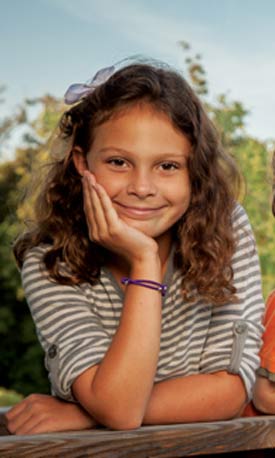 At first her parents weren't sure she would live.
At first her parents weren't sure she would live.
She survived.
Then they didn’t know if she would walk or talk again.
She did both.
Then they thought she would have to repeat the third grade.
She finished it with her class – earning straight As.
Megan amazed everyone.
Lisa Berotti remembers getting the call in October 2011 that her 8-year-old daughter had been in an accident. “The friend who called was so calm that I thought it had been something minor in the parking lot,” she says. “So when my husband called right afterward to say a helicopter was taking Megan to the hospital, I thought, why does she need a helicopter?”
Lisa soon learned why. Megan had been gravely injured after being hit by a car that was traveling the 45-mile-an-hour speed limit on Sandbridge Road in Virginia Beach. The driver simply hadn’t seen the third-grader as she dashed across the road to get to soccer practice.
The serious head injury Megan sustained in the accident caused her brain to swell, known in medical terms as cerebral edema. After being airlifted to the trauma center at Sentara Norfolk General Hospital and stabilized, Megan was rushed next door to CHKD’s Pediatric Intensive Care Unit. There, CHKD neurosurgeon Joseph Dilustro, MD, placed an intracranial pressure monitor in Megan’s head that allowed the PICU team to monitor the pressure in her brain.
That first night, Lisa says, “It seemed like there were 20 people around Megan’s bed working on her.”
 Dr. Christopher Foley is one of the CHKD pediatric intensivists who oversaw Megan’s care. He explains that the brain swelling she experienced usually takes three to five days to subside. Until the swelling went down, Megan’s brain activity needed to be minimized and monitored around the clock.
Dr. Christopher Foley is one of the CHKD pediatric intensivists who oversaw Megan’s care. He explains that the brain swelling she experienced usually takes three to five days to subside. Until the swelling went down, Megan’s brain activity needed to be minimized and monitored around the clock.
“We kept her heavily sedated and in a sleep state because her brain needed to be as quiet as it could be,” Dr. Foley explains. “Some days we would let her wake up a little to see if anything had changed. It was a moment-to-moment approach.”
But five days after the accident, Megan’s brain remained swollen. On day six, the swelling still hadn’t subsided. Nor on day seven or eight. “The longer it took, the more worried we became,” Dr. Foley says.
The clinical team might have been concerned, but Megan’s parents hadn’t lost faith. “Megan has always been a fighter,” says her dad, John. Maybe it’s because she’s the middle child, a girl sandwiched between two brothers, 11-year-old Ryan and 7-year-old Drew.
“I remember Ryan asking us, ‘When she wakes up, will she be the same Megan she was before?’” Lisa says. “No one could answer that question.”
Finally on day 10, good news: Megan’s brain swelling had subsided. “We were able to wake her up and take her off the ventilator,” Dr. Foley says. “I think her family being so optimistic was just as important as anything else in Megan’s recovery.”
Over the next few days, as the sedatives moved out of her system, Megan was able to follow simple commands, such as giving a little wave and sticking out her tongue.
By day 15, she was chair-dancing to music in her headphones and asking for kisses from her dad. “Today, we are on top of the world,” Lisa wrote in the online journal she kept during Megan’s recuperation. The next day, Megan was moved from the PICU to a regular room. “At that point,” Dr. Foley recalls, “we still weren’t sure how complete her recovery would be.”
Four days later, Megan was transferred again, this time to CHKD’s Inpatient Rehabilitation Unit. There she began an intensive daily regimen of speech, physical and occupational therapies, as well as classes with the hospital schoolteacher.
“At first,” says CHKD speech pathologist Erin Douglass, “when I asked Megan at 10 o’clock what she’d had for breakfast a few hours earlier, she couldn’t remember.” That’s not unusual, Erin explains. Children who’ve had head injuries often need help regaining their memory and reasoning skills. “Megan really pushed herself. She was a super hard worker. By the time she was discharged, she was solving complicated problems and responding to complex memory commands.”
CHKD physical therapist Lindsay Schuler says Megan eagerly tackled every activity she was given. “Her strength and mobility returned so quickly that I had to work hard to find activities that would challenge her,” Lindsay says.
Both therapists credit her parents with playing a vital role in Megan’s recovery. “They participated every single day,” Erin says. “They did all the homework drills I gave them to do with Megan. They were wonderful.”
Lindsay agrees. “They were right on top of everything we gave them,” she says, including scooter races in the hospital to help strengthen Megan’s legs. “I don’t want to talk about those,” John Berotti says, laughing. “I always lost.”
After seven weeks of hospitalization, Megan was discharged the day before Thanksgiving. By January, she was back in school full-time. She continued outpatient physical and occupational therapies for several weeks and speech therapy for three months. Today, twice-yearly follow-up visits with CHKD rehabilitation specialist Jean Shelton, MD, are Megan’s only reminders of the accident.
Dr. Foley attributes her excellent outcome to all of Megan’s therapists, nurses and specialists working together as a team. “It wasn’t just one person. It was all of those people doing their jobs well. Every little part of her care added up.”
He also points out that his youngest daughter and Megan once attended the same Virginia Beach school, so he knew the Berotti family by sight before the accident. “I hope it was reassuring to them to see someone here they knew,” he says. “It reminded me that at CHKD, we’re often taking care of our friends’ and neighbors’ children.”
Dr. Shelton and Dr. Foley practice with Children's Specialty Group at CHKD. Dr. Dilustro is with CHKD Surgical Group’s neurosurgery practice.
This story was featured in the Spring 2013 issue of KidStuff, a publication of Children's Hospital of The King's Daughters.